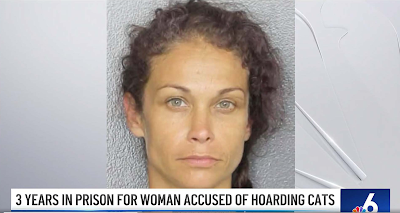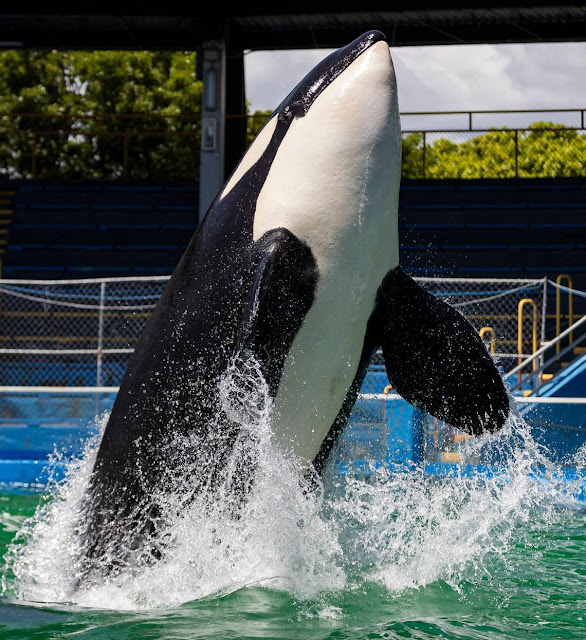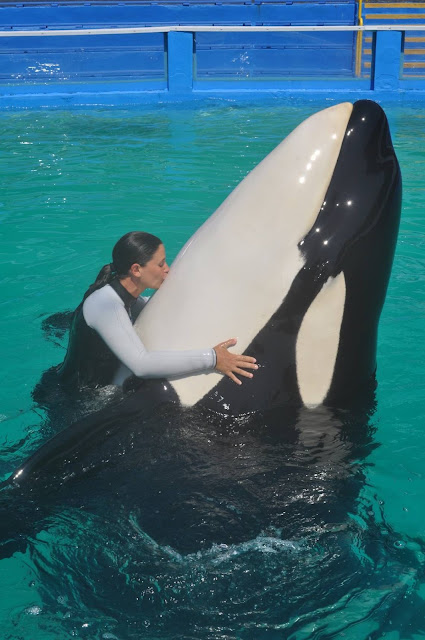In South Florida, where most of the year the weather is a perfect paradise, it also means many animals live here in the wild and in captivity at attractions. One current hot issue is Lolita the killer whale at the Miami Seaquarium attraction. There is mounting pressure to release the whale to her "natural habitat" the open sea where she has more space to swim and roam. If only it were that simple. Animal rescuers/ pet advocates and scientists are at odds. Most scientists are against releasing Lolita except for marine biologist Ken Balcomb.
For 25 years, Balcomb has been lobbying for Lolita's release to reunite her with her family and restore balance in her native waters, with fisheries and other whales. The problem for most other scientists, 25 years is much too late and poses great risks.
At Pawsitively Humane, we are reminded "think with your head, not just your heart".
Most of us are not marine experts. But to begin to relate and comprehend, we turned to our own community of long-time pet rescuers, especially those who work with feral cats, and posed this question to understand the pros and cons of releasing the whale:
Would you release an indoor cat that has lived in your home for 10 years with food, attention, (albeit limited space) into a fenced off outdoor area to be with other cats?
The answer was a resounding no. We know as cat educators that other community cats may not welcome your beloved indoor cat and may try to attack your Cleo. Even worse, Cleo's health is not resistant to fleas, ticks, mosquitoes, and other pathogens.
Is this a fair comparison? Cats and Whales.
For long time pet rescuers many would say yes. Cats are inherent hunters, the outdoors is their natural habitat. They need vertical (trees) and horizontal space to climb and run freely. Whether on farmland, in the countryside of places like Tuscany, Italy, the coastline of Mediterranean, or riding on ships in historic English times, cats are outdoor creatures. Yet many of us beg people to adopt them, to take them indoors where they are forced to live confined within walls with limited space to climb and run. To rescue them from a new environment-- a rough life in city streets. City life and highways with few food sources is not ideal for cats. However, we also know cats adapt to the indoors and are generally happy.
The point: the outdoor environment is evolving. It may be safe one day, and changes in nature, as well as human neglect, poses a dangerous environment. Returning a long-held captive animal to an environment with unfamiliar sights, sounds, temperatures, creatures,dangers and toxins or a whole new environment can be stressful for many animals.
Everyone Agrees Lolita Needs More Space
Scientists and animal activists on both sides of the Lolita issue agree that a bigger tank is the ideal situation for Lolita. However building one now is not feasible.
But is Lolita safer where she is now after all this time?
What is a "Suitable" Environment for a Whale in Long-Term Captivity?
Balcomb and the Lummi Tribe, a native American Indian tribe from the
region where Lolita was captured, believe a sectioned off sea pen with
plans to slowly rehabilitate her and reintroduce Lolita to
natural whale
sea life has to work.
The biggest risk according to scientists who oppose it say it is due to her age. For 43 of her 47 years she knows only one home, one environment, the tank at the Seaquarium with her constant roommates the dolphins and her daily caretakers, the feeders and trainers.
Transplating to her native waters and surroundings would not be natural to the captive whale.
The Tragic Case of Releasing Keiko the Killer Whale
Opposing scientists point to many cases and the famous case of releasing Keiko the killer whale inspired by the movie "Free Willy". Keiko, living in a tank in an amusement park in Mexico, was released to his natural waters. Unfortunately the whale did not adapt and kept swimming back to his owner's boats. He missed his human. He missed home. More tragic, his body and immune system not accustomed to the pathogens in the ocean water, developed pneumonia and died within a year. Keiko was 26 years old.
 |
| Keiko in a sling about to be released in sea pen in Heimaey, Iceland |
We see this human bond with our own outdoor pets whether it's cats, pigs, horses...Why would whales be any different?
The Human Bond with Lolita the Killer Whale
It was late one night in 1989 when Craig Pelton, then a
young whale trainer, snuck into the whale stadium at Miami Seaquarium
after it closed and waded into the 50 degree water.
After-hours whale swims
were categorically prohibited, so, naturally, the trainers did it from
time to time, Pelton said. It was a time before “Blackfish,” before a
trainer had been killed by a captive whale, before the “Free Lolita”
movement started making waves. In the water, Pelton
watched as Lolita swam over. The orca was in her mid-20s by then, about
20 feet long and 7,000 pounds. A full moon illuminated the stadium
below. Lolita paused and put
her pectoral fin under his body — then she snuggled to his side. On
Pelton’s other side, Lolita’s tank mate Makani, a Pacific white-sided
dolphin, did the same. “I laid there for about
five, 10 minutes, all three [of us] at the surface,” Pelton said. “She
was just a sweet animal that was just amazing to work with.”
Change and assimilation are at the heart of the argument against Lolita’s release.
“You would have to be just so incredibly careful about how you
approximate that change. You can’t control the heavy metal toxicity in
the water that is prevalent in our coastal regions. You can’t control
the pathogens, the bacteria; her immune system is not adept,” said
Mark Simmons, director of husbandry on the Keiko project and also authored a book on Keiko’s death called “Killing
Keiko.”
Read more here: http://www.miamiherald.com/news/business/article185517463.html#storylink=cpy
The Miami Herald spoke
to a dozen experts on killer whales around the nation. They included
experts without a stake in Lolita’s case, some who worked on the Keiko
release project, scientists currently working on seaside sanctuary
projects for aquatic mammals and her caretakers at the Seaquarium. The vast majority said they would advise against moving Lolita to the Pacific Ocean or a seaside sanctuary. [Miami Herald November 2017]
Read more here: http://www.miamiherald.com/news/business/article185517463.html#storylink=cpy
Read more here: http://www.miamiherald.com/news/business/article185517463.html#storylink=cpy
What Went Wrong in the Campaign to Release Lolita?
Time and Money. If this was 1995, timing was more optimal to transition Lolita back to sea life. Unfortunately, it takes time to educate government and the public but also to collect money, donations. If campaigning requires significant funding so does implementing the plan and overseeing it. The entire project of logistics (transportation) and constant care from a medical standpoint (veterinary) and her daily interaction with humans would amount to millions of dollars.
One Silver Lining, Lolita the Ambassador
While Lolita may never be released, one result both sides can agree on is that Lolita continues her role as the ambassador for releasing captive whales. The trend is declining with new fervor and enacted laws prohibiting the captivity of orca whales or any ocean mammals. Lolita remains one of three killer whales still housed in amusement attractions in the U.S.
A Future Marine Scientist
Upon visiting the Seaquarium to talk to protestors, I overhead a young boy ask his mother "Are we going to see Lolita again?". "Of course," replied the mother. Then he asked "Who were those people with whale costumes and signs?" The mother explained they wanted to see Lolita the whale returned to her home. That she was taken from her home years ago, from her family. The boy then asked how long has Lolita been here? "A long time," replied the mother." "Longer than the other place?" he continued. "Yes many more years," answered the mother. "Well he has friends, the dolphins and his teachers here and plenty of fish food. Why would they take her away from home again?" Aaah the innocence and clarity of a child's mind. Maybe this is the confirmation we need to accept Lolita's fate with some ease.
 |
| Christine Michaels with her nephew Gabriel in 2014 visiting Miami Seaquarium |
by Christine Michaels

















.png)
.png)
.png)
.png)

.png)
.png)
.png)
%20(1).png)



























